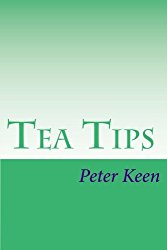
Tea Tips is not a book “about” teas but a guide to help you enjoy as wide a range of them as you feel it’s worth your knowing about, and to get best value in your purchases. There’s far more to choose from than you’ll find on the shelves of supermarkets and the typical tea bag is as representative of the 3,000 teas on the market as instant coffee is of mochas, lattes and cappuccinos, or as hot dogs are of steak. At the same time, there's no reason to fall for the hype and snobbery about tea and end up paying a premium for the packaging and Royal names. Even the best is relatively inexpensive: typically, less than 50 cents a cup for a tea with a combination of flavors and aromas as varied as those among wines. The goal of Tea Tips is to give you a sense of the choices and how to pick the ones for you. Its a navigation aid: a map of the territory with suggestions on where to stop, side trips and special sights. You don’t have to become an expert or tea snob to find them. But you won’t know what you’d like if you don’t know what’s out there. That goes well beyond the tea bag. Tea is marked by two very distinct paths from the bush where the fresh leaf grows to the finished leaf that ends up in your cup: Artisan and Agribusiness. The question Tea Tips aims at answering is What is it worth your knowing about this? 1. How tea is made, what creates the differences and what to look for. It’s all about the leaf. Artisan whole leaf tea relies on hand plucking at seasonal peaks to select the “two buds and a leaf” containing hundreds of compounds that generate flavors. Agribusiness tea farming uses machines, additives in many instances, and streamlined production to make teas that are standardized and far less complex. 2. Myths and misinformation that put people off tea or lull them into sticking with second-rate ones at top prices. Here are just two: (1) Green tea is lower in caffeine than black ones; not necessarily.(2) English tea is special. There’s no such thing. 3. The complex issues of tea and health and weight loss: the scientific evidence is highly inconclusive. It doesn’t cure illnesses or make you lose weight. Some “healthy’ teas are downright scary, especially herbal ones and supplements. Choose the tea you enjoy; if it does indeed provide medicinal or lifestyle benefits, you’ll get them anyway. 4. Making tea: If you find tea too bitter or flat, it’s more likely to be you than the tea: brewing it too long, at the wrong temperature or in the microwave. Look after the water and the tea will look after itself. 5. Shopping: Whole leaf tea is not expensive. 25-50 cents for a cup. Tea bags and blends are typically 20 cents a cup.